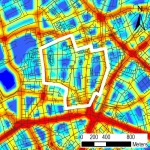 Alessandro Venerandi, Mattia Zanella, Ombretta Romice, Sergio Porta
Alessandro Venerandi, Mattia Zanella, Ombretta Romice, Sergio Porta
Environment and Planning B: Urban Analytics and City Science, 44(6): 1056-1076, 2017.
Many socioeconomic studies have been carried out to explain the phenomenon of gentrification. Although results of these works shed light on the process around this phenomenon, a perspective which focuses on the relationship between city form and gentrification is still missing. With this paper we try to address this gap by studying and comparing, through classic methods of mathematical statistics, morphological features of five London gentrified neighbourhoods. Outcomes confirm that areas which have undergone gentrification display similar and recognizable morphological patterns in terms of urban type and geographical location of main and local roads as well as businesses. These initial results confirm findings from previous research in urban sociology, and highlight the role of urban form in contributing to shape dynamics of non-spatial nature in cities.
Philip Ball’s comment on The Guardian:  Gentrification is a natural evolution | Philip Ball | Comment is free | theguardian.com
Gentrification is a natural evolution | Philip Ball | Comment is free | theguardian.com